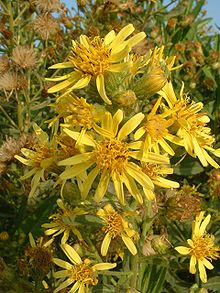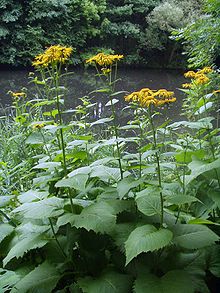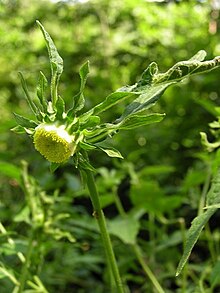Inuleae
| Inuleae | ||||||||||||
|---|---|---|---|---|---|---|---|---|---|---|---|---|

Common elephant ( Inula helenium ) |
||||||||||||
| Systematics | ||||||||||||
|
||||||||||||
| Scientific name | ||||||||||||
| Inuleae | ||||||||||||
| Cass. |
The tribe inuleae belongs to the subfamily Asteroideae within the plant family of the daisy family (Asteraceae). It contains 40 to 60 plant genera with 500 to 600 species.
description


Appearance and leaves
They are usually one to two year old or perennial herbaceous plants , less often sub-shrubs , shrubs or small trees .
The foliage leaves, which are usually alternate, rarely opposite, are distributed in basal rosettes or on the stem and are stalked or sessile. The leaf blades are usually simply or rarely pinnately divided. The leaf margins are smooth, serrated or serrated.
Inflorescences, flowers and fruits
The cup-shaped inflorescences are sometimes individually or often together in branched, corymbic , paniculate or racemose overall inflorescences . The flower heads are more or less disc-shaped. The bracts, which are more or less different in shape and size, are rarely only two, usually three to more than seven rows together; their edges and tips are mostly paper-like. The flat to convex , rarely concave bottom of the basket is usually hairless.
In the cup-shaped inflorescence there are ray and tubular flowers. All flowers are mostly yellow, sometimes reddish to rarely purple. At the edge there are usually one, rarely two or more rows zygomorpher ray florets , called ray florets; they are mostly female and fertile . The radially symmetrical tubular flowers , so-called disc flowers, are hermaphroditic and all fertile with mostly four, rarely five corolla lobes. The anthers have appendages. Usually no appendages can be seen on the stylus.
All achenes of an infructescence are usually the same and often ribbed. In this tribe there is usually a pappus . The pappus bristles are usually bearded to rarely feathery.
Systematics and distribution









The Tribus Inuleae was set up in 1819 by Alexandre Henri Gabriel de Cassini in Journal de Physique, de Chimie, d'Histoire Naturelle et des Arts , 88, pages 193-195. The type genus is Inula L. The botanical genus name Inula is derived from the Greek word hinaein for emptying, cleaning, this refers to the laxative effect of the "root stock" of some Inula species.
From the formerly much larger tribe Inuleae the tribe Gnaphalieae were separated; before that this tribe had a range of up to 200 genera and 2000 species. The relationships of the genus of the tribe Inuleae Cass. and Plucheeae (Cass. ex Dum.) Anderberg has been discussed for a long time, and it has been a question since Anderberg et al. 2005 by two subtribes Plucheinae Cass. ex dum. and Inulinae (Cass.) Dum. within the tribe Inuleae.
The taxa of the Inuleae tribe are primarily native to the Old World . In North America they spread with some genera and many species mainly through humans ( neophytes ). The main distribution area is in Eurasia and northern Africa. They thrive in tropical, subtropical, and temperate areas.
The tribe Inuleae contains about (40 to) 60 genera with about 500 to 600 species:
- Adelostigma Steetz : The only two species are common in tropical Africa.
- Allagopappus Cass. : The two types of evergreen shrubs are native to the Canary Islands.
-
Allopterigeron Dunlop : it contains only one species:
- Allopterigeron filifolius (F.Muell.) Dunlop (Syn .: Pluchea filifolia F.Muell. , Pterigeron filifolius (F.Muell.) Benth. ): It is common in the northern Australian states of Western Australia , Northern Territory and Queensland .
-
Amblyocarpum fish. & Mey. : It contains only one type:
- Amblyocarpum inuloides fish. & Mey. : It occurs in the Caucasus region.
- Antiphiona Merxm. : The two species are only found in Namibia .
- Anvillea DC. (Syn .: Anvilleina Maire ): It contains only two species that occur in the northern Mediterranean.
-
Asteriscus Tourn. ex Mill .: The eight or so species are common in the Mediterranean and Macaronesia . Including:
- Annual beach star ( Asteriscus aquaticus (L.) Less. )
-
Blumea DC. (Syn .: Blumeopsis Gagnepain. , Nanothamnus Thoms. , Merrittia Merr. , Leveillea Vaniot , Placus Lour. ): The (50 to) about 100 species are distributed in tropical Asia, Africa and Australia, on the Philippines and on Pacific islands. There are about 30 species in China, six of them only there. 2008 was added to the genre:
- Blumea sericea (Thoms.) Anderb. & AKPandey (Syn .: Nanothamnus sericeus Thoms. ): This endemic occurs only in western India in the Western Ghats in the districts of Nasik, Pune and Shimoga in Maharashtra and Kamataka.
-
Ox eyes ( Buphthalmum L. ): The only two to three species are common in Europe:
- Buphthalmum inuloides Moris : It is endemic to Sardinia .
- Ox-eye ( Buphthalmum salicifolium L. )
-
Caesulia Roxb. : It contains only one type:
- Caesulia axillaris Roxb. : It occurs in the Himalayas of India, Nepal and Myanmar.
- Calostephane Benth. : With six species in tropical Africa and Madagascar.
- Collar flowers ( Carpesium L. ): The 20 or so species are common in Eurasia, 16 of them in China.
-
Chiliadenus Cass. : The ten or so species are common in the Mediterranean, for example:
- Chiliadenus bocconei Brullo (Syn .: Jasonia bocconei (Brullo) M.Pardo & R.Morales )
- Chrysophthalmum Sch.Bip. : The three or so species are common in Turkey, Syria and Iraq.
-
Coleocoma F. Muell. : It contains only one type:
- Coleocoma centaurea Roxb. : It is common in the northern Australian states of Western Australia and Northern Territory.
- Cratystylis S.Moore : The roughly three diocesan species are common in Australia.
-
Delamerea S.Moore : It contains only one species:
- Delamerea procumbens S.Moore : It is common in East Africa.
-
Klebalant ( Dittrichia Greuter ): The only two species native to the Mediterranean area are almost worldwide neophytes:
- Narrow-leaved Klebalant ( Dittrichia graveolens (L.) Greuter , Syn .: Inula graveolens (L.) Desf. , Inula quadridentata Lag. )
- Broad-leaved Klebalant ( Dittrichia viscosa (L.) Greuter ): There are four subspecies.
- Duhaldea DC. : The approximately 14 species are distributed in Africa, central and eastern Asia and Southeast Asia. There are eight species in China, three of which are only there.
- Epaltes Cass. : The approximately 14 species are distributed in Africa, Asia, Australia, Central and South America.
- Geigeria Griess. : Of the approximately 27 species, 21 are distributed in the Capensis and the remaining species in other parts of Africa.
-
Ighermia Wikl. : It contains only one type:
- Ighermia pinifolia (Maire & Wilczek) Wikl. : It occurs in Morocco.
- Alant ( Inula L. ): The approximately 100 species are common in Africa and Eurasia. In China there are 17 species of which three are only there. Three types are neophytes in many areas of the world.
- Iphiona Cass. : The eleven species are distributed in Egypt , Israel , Jordan , Sudan , Ethiopia , Somalia , Saudi Arabia , Yemen , Oman , Iran and Pakistan .
- Iphionopsis A.Anderb. : The only three species are common in Africa including Madagascar.
-
Jasonia Cass. : It contains only one species:
- Jasonia tuberosa (L.) DC. (Syn .: Jasonia obtusifolia Pau ): It probably only occurs in Spain.
-
Karelinia Less. : It contains only one type:
- Karelinia caspia (Pallas) Lessing : It occurs in central and southwest Asia, Caspian region.
- Laggera Schultz Bip. ex C. Koch : The approximately 17 species are distributed in tropical Africa, Arabia and Asia.
-
Lifago Schweinf. & Muschl. : It contains only one type:
- Lifago dielsii Schweinf. & Muschl. (Syn .: Niclouxia saharae Batt. ): It occurs in Algeria and Morocco.
-
Limbarda Adans. : It contains the two species in Eurasia and North Africa:
- Salt elephant ( Limbarda crithmoides (L.) Dumort. , Syn .: Inula crithmoides L. )
- Limbarda salsoloides (Turcz.) Ikonn. : It only occurs in Mongolia .
- Monarrhenus Cass. : Of the only two species, one occurs only on Réunion and the other on Réunion and Mauritius and.
-
Neojeffreya Cabr .: It contains only one type:
- Neojeffreya decurrens (L.) Cabrera : It comes from Madagascar and is a neophyte in parts of Africa.
-
Ondetia Benth. : It contains only one type:
- Ondetia linearis Benth. : It only occurs in Namibia .
- Pallenis Cass. : The three to six species are common in the Mediterranean and the Middle East.
-
Pechuel-Loeschea O. Hoffm . : It contains only one type:
- Pechuel-Loeschea leubnitziae : It occurs only in Namibia.
- Pegolettia Cass. : The approximately nine species are common in Africa and the Middle East; all also occur in the Capensis.
- Pentanema Cass. : It contains at least 17 to 18 species. Since 2018, several species that were previously included in the genus Inula have also been produced here. Then this genus is common in large parts of Eurasia and Africa.
- Perralderia Coss. : The only three species and two subspecies are common in North Africa.
- Pluchea Cass. : The approximately 80 species are distributed in Africa, Southeast Asia, Australia, the New World and on Pacific islands.
- Pseudoblepharispermum Lebrun & Stork : The only two species are common in East Africa.
-
Pseudoconyza Cuatr. : It contains only one type:
- Pseudoconyza viscosa (Mill.) D'Arcy : It occurs in Central America, Africa, southwest Asia, on the Indian subcontinent and in Taiwan.
- Pterocaulon Elliot : The approximately 18 species are distributed in Southeast Asia, Australia, North and South America.
- Flea herbs ( Pulicaria Gaertn. ): The 77 to over 100 species are common in Africa and Eurasia.
- Rhanteriopsis S.Rauschert : The four species have a western distribution area in Lebanon and Syria and an eastern distribution area in Iran and Iraq along the Iranian border.
- Rhanterium Desf. : The roughly three species are distributed in western North Africa, the Arabian Peninsula, Iraq and Iran.
-
Rhodogeron Griseb. : It contains only one type:
- Rhodogeron coronopifolius Griseb. : It only occurs in Cuba .
-
Schizogyne Cass. : The only two species occur only in the Canary Islands:
- Bald Schizogyne ( Schizogyne glaberrima DC. )
- Silky-haired Schizogyne ( Schizogyne sericea (L. f.) DC. )
- Sphaeranthus L .: The three or so species are found in tropical to subtropical Africa and Asia, some species also in Australia.
- Stenachaenium Benth. : The five or so species are common in South Africa.
-
Telekia Baumg. : It contains only one species:
- Large Telekie ( Telekia speciosa (Schreb.) Baumg. , Syn .: Telekia cordifolia DC. ): It is widespread in northern Turkey, in the Caucasus region, in Eastern Europe ( Hungary , Poland , Slovakia , Ukraine ) and Southeastern Europe.
-
Thespidium F. Muell. ex Benth. : It contains only one type:
- Thespidium basiflorum F. Muell. : It is common in the northern Australian states of Western Australia , Northern Territory and Queensland .
-
Triplocephalum O. Hoffm . : It contains only one type:
- Triplocephalum holstii O. Hoffm . : It is common in East Africa.
-
Varthemia DC. : It contains only one type:
- Varthemia persica DC. : It is common in Iran, Afghanistan and Pakistan.
-
Vieraea Webb & Berth. : It contains only one type:
- Vieraea laevigata Webb & Berth. : It occurs only in the Canary Islands.
-
Xerolekia Anderb. : It contains only one type:
- Small Telekie ( Xerolekia speciosissima (L.) Anderb. , Syn .: Buphthalmum speciosissimum Ard. , Telekia speciosissima (L.) Less. ): This endemic occurs only in northern Italy between Lake Lugano and Lake Garda.
swell
literature
- Chen Yousheng, Arne Anderberg: Tribe Inuleae. In: Wu Zheng-yi, Peter H. Raven, Deyuan Hong (Eds.): Flora of China . Volume 20-21: Asteraceae . Science Press / Missouri Botanical Garden Press, Beijing / St. Louis 2011, ISBN 978-1-935641-07-0 , pp. 820-845 (English, online ). (Sections Description and Systematics)
- Rubén Torices, Arne A. Anderberg: Phylogenetic analysis of sexual systems in Inuleae (Asteraceae). In: American Journal of Botany. Volume 96, No. 5, 2009, pp. 1011-1019, doi: 10.3732 / ajb.0800231 . (Section systematics)
- Jose L. Panero, Vicki A. Funk: The value of sampling anomalous taxa in phylogenetic studies: Major clades of the Asteraceae revealed. In: Molecular Phylogenetics and Evolution. Volume 47, No. 2, 2008, pp. 757-782, doi: 10.1016 / j.ympev.2008.02.011 , PDF file .
- Arne A. Anderberg, Pia Eldenäs: Tribe Inuleae. In: Joachim W. Kadereit, Charles Jeffrey (Eds.): The Families and Genera of Vascular Plants . Volume 8: Flowering Plants. Eudicots. Asterales . Springer, Berlin / Heidelberg / New York 2007, ISBN 978-3-540-31050-1 , pp. 374-391 (English).
- Theodore M. Barkley, Luc Brouillet, John L. Strother: Asteraceae tribe Inuleae. In: Flora of North America Editorial Committee (Ed.): Flora of North America North of Mexico . Volume 19: Magnoliophyta: Asteridae, part 6: Asteraceae, part 1 (Mutisieae – Anthemideae). Oxford University Press, New York / Oxford a. a. 2006, ISBN 0-19-530563-9 , pp. 471 (English, online ). (Sections Description and Systematics)
- Arne A. Anderberg, Pia Eldenäs, Randall J. Bayer, Markus Englund: Evolutionary relationships in the Asteraceae tribe Inuleae (incl. Plucheeae) evidenced by DNA sequences of ndhF; with notes on the systematic positions of some aberrant genera. In: Organisms Diversity & Evolution. Volume 5, No. 2, 2005, pp. 135-146, doi: 10.1016 / j.ode.2004.10.015 , full text.
Individual evidence
- ↑ a b Theodore M. Barkley, Luc Brouillet, John L. Strother: Asteraceae tribe Inuleae. In: Flora of North America Editorial Committee (Ed.): Flora of North America North of Mexico . Volume 19: Magnoliophyta: Asteridae, part 6: Asteraceae, part 1 (Mutisieae – Anthemideae). Oxford University Press, New York / Oxford a. a. 2006, ISBN 0-19-530563-9 , pp. 471 (English, online ).
- ↑ Inuleae at Tropicos.org. Missouri Botanical Garden, St. Louis
- ↑ Key to the genera of the Inuleae from Checklist of the Compositae of Bolivia .
- ↑ Enter the taxon in the search mask for The Global Compositae Checklist .
- ↑ a b c d e f g h i j k l m n o p q r Werner Greuter Compositae (pro parte majore). In: Werner Greuter, Eckhard von Raab-Straube (ed.): Compositae. in Euro + Med Plantbase - the information resource for Euro-Mediterranean plant diversity. Inuleae . Berlin 2006.
- ^ CR Dunlop: Allopterigeron Dunlop, a new genus from Northern Australia. In: Journal of the Adelaide Botanic Gardens. Volume 3, No. 2, 1981, pp. 183-186 (PDF file) .
- ↑ a b c d e Chen Yousheng, Arne Anderberg: Tribe Inuleae. In: Wu Zheng-yi, Peter H. Raven, Deyuan Hong (Eds.): Flora of China . Volume 20-21: Asteraceae . Science Press / Missouri Botanical Garden Press, Beijing / St. Louis 2011, ISBN 978-1-935641-07-0 , pp. 820-845 (English, online ).
- ^ Arne A. Anderberg, Arun K. Pandey: Nanothamnus sericeus Thomson, a derived species of Blumea. In: Compositae Newsletter. Volume 46, 2008, pp. 8-13 (digitized version) .
- ↑ David Gutiérrez-Larruscain, Maria Santos-Vicente, Arne A. Anderberg Enrique Rico, M. Martínez-Ortega: Phylogeny of the Inula group (Asteraceae: Inuleae): evidence from nuclear and plastid genomes and a recircumscription of Pentanema. In: Taxon , Volume 67, Issue 1, March 2018, pp. 149–164. doi : 10.12705 / 671.10
Web links
- Entry in the Tree of Life project . (engl.)
- The (South) African genera of the tribe at the biodiversityexplorer of Iziko.
further reading
- Markus Englund, Pimwadee Pornpongrungrueng, Mats HG Gustafsson, Arne A. Anderberg: Phylogenetic relationships and generic delimitation in Inuleae subtribe Inulinae (Asteraceae) based on ITS and cpDNA sequence data. In: Cladistics , Volume 25, Issue 4, 2009, pp. 319–352. doi : 10.1111 / j.1096-0031.2009.00256.x
- Pimwadee Pornpongrungrueng, Mats HG Gustafsson, Finn Borchsenius, Hiroshige Koyama, Pranom Chantaranothai: Blumea (Compositae: Inuleae) in continental Southeast Asia. In: Kew Bulletin , Volume 71, Issue 1, 2016. doi : 10.1007 / s12225-016-9612-2
- Stephan Nylinder, Arne A. Anderberg: Phylogeny of the Inuleae (Asteraceae) with special emphasis on the Inuleae ‐ Plucheinae. In: Taxon , Volume, 64, Issue 1, 2015, pp. 110–130.


